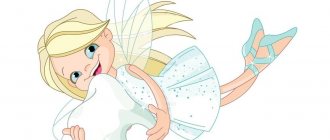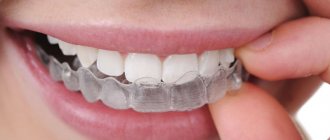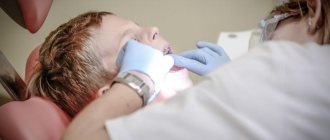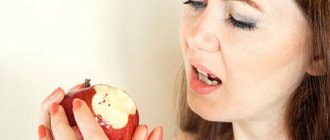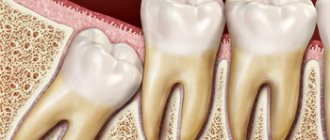The first reaction of parents who notice that their child is growing a second row of teeth is natural fear. In dentistry, it is generally accepted that there are two causes of pathology:
- abnormal growth of molars;
- polyodontia or supernumerary teeth.
Normally, permanent teeth replace baby teeth only after the latter fall out. The germ of the molar tooth stretches upward, thereby contributing to the destruction of the roots. With some features of jaw development, this does not happen, which is why the second row appears.
Reasons for the growth of the second dentition in a child
Double or “shark” teeth in children appear when the baby tooth and the rudiment of the molar are located at different points in the oral cavity. When a new set erupts, the baby tooth remains in place. A tooth grows above a tooth, which not only does not look aesthetically pleasing, but also interferes with the development of the rest of the row.
The most common reason why teeth do not change is improper breathing. A lot depends on how a child breathes. Breathing disorders lead to problems with bite, deterioration of posture and changes in facial shape.
A child’s jaw develops correctly only when he breathes correctly through his nose. The tongue in this position presses on the palate from the inside. A natural semicircular shape of the jaw is formed, in which there is enough space for all the molars. This is why it is so important to teach your child to breathe through his nose to prevent the growth of the second row of teeth.
Growth of baby teeth in the second row
Hyperdontia (supernumerary tooth) in the picture
The rudiments of baby teeth are formed in the womb, so their pathologies are associated with a lack of space in the jaw for all the incisors. Among the most common reasons that provoke improper growth of baby teeth:
- unbalanced diet of a woman during pregnancy;
- deficiency of calcium, fluorine (essential microelements necessary for the formation of bone tissue);
- lack of solid food;
- uncontrolled use of a pacifier;
- heredity.
It also happens that molars and molars come in second row. This phenomenon is explained by the following factors:
- underdevelopment of the jaw, due to which there is not enough space to accommodate a full set of teeth;
- hyperdontia (superset of teeth).
Supernumerary teeth in children
The appearance of additional tooth buds is rare, occurring in only 2% of cases. The anomaly is associated with a disorder of embryonic development. A tooth that appears above a child's tooth is usually removed. But this does not always happen: if the tooth does not disturb the shape and aesthetics of the dentition, the dentist can leave it.
Sometimes supernumerary teeth are located outside the dental arch. The appearance of a tooth on the palate of a child is rare, however, this is no exception. There is no need to be afraid of this: it does not affect your health in any way. The Natadent clinic has a pediatric orthodontist who will help solve this problem quickly and painlessly.
Dear Doctor Orthodontist
The specialist will also examine the oral cavity and select an apparatus for correcting the dentition:
- trainer - silicone or polyurethane device, mouthguard. Wear it for an hour before bed. The materials are light and easy to clean. The device corrects bite and diction, and also creates additional rigidity. This will help the jaw to expand for new teeth;
- plate with expansion screw - a spacer made of soft plastic, with metal arches and a screw in the middle. It fits against the roof of your mouth and gums and provides pressure to your jaw and teeth. Indications: correction of jaw shape, teeth position, palate stretching;
- palatal clasps are metal arches that are secured with hooks on two or four teeth. Rings are placed on the teeth, to which hooks are attached. Also, plates with screws are considered a type of clasp. Such devices correct the shape of only the upper jaw. But with their help you can move your teeth forward or backward, fix them and even tilt them.
- And the most famous way to straighten teeth is braces. The structure is not removable thanks to the fixing glue-bond, which covers the teeth from the outside or inside. And an elastic arc made of steel or an alloy of nickel and titanium slowly but inevitably brings the “shark” smile into a Hollywood state.
The choice of correction method depends on the reason for the lack of space for teeth:
- physiological feature of tooth formation;
- insufficient jaw growth.
The age of the small patient is also taken into account. Braces can be installed from the age of 10, but they will work more effectively from the age of 12, when permanent teeth are actively growing. Up to 12 years old, plates and trainers are suitable. The second row of teeth is not a reason for frustration, but an opportunity to create a beautiful smile.
What to do if the child’s teeth grow in the second row?
When a doctor sees a tooth above a patient’s tooth, he immediately understands what’s wrong. First, the orthodontist removes the baby tooth. After this, the permanent tooth will move into place on its own under the action of the tongue muscle, if there is enough space. But what to do if a child has a lack of space for molars?
The primary task of the dentist and parents will be to restore normal breathing. At this stage, it is necessary to “retrain” the muscles of the mouth to work differently. This is where trainers or mouthguards come to the aid of specialists.
Orthodontic appliances solve several important problems:
- train the muscles of the oral cavity, stimulating their natural development;
- correct the direction of development of the child’s jaws;
- correct the position of the tongue in the oral cavity;
- teach the child to breathe through the nose;
- get rid of bad habits.
Wearing trainers is most often considered as a preparatory stage. After this, more serious orthodontic treatment begins with the use of braces. However, here the first step is the most important, since the effectiveness of further work depends on it.
Dairy vs permanent
But it happens that permanent teeth begin to form prematurely, when their milk predecessors are not yet ready to part with their roots. Therefore, there is no other way but a roundabout one - and a “shark” row emerges.
An unfavorable condition is breathing through the mouth. When the jaws are closed, the tongue presses evenly on them. When the mouth is slightly open, there is no pressure from the inside on the upper jaw. Therefore it does not expand. As a result, the teeth themselves find loopholes - in any place other than where they should be.
A child may breathe through his mouth due to constant colds that he brings from school in addition to homework.
How to understand that a child is at risk of growing teeth in two rows?
Attentive parents should monitor the process of teeth growth and loss. The change of dentition begins at 6-8 years: the first to fall out are the central and lateral incisors. At 9-11 years old, the lower canines change. By the age of 10-12, the upper canines and small molars grow. The formation of the bite ends at the age of 13-14 years.
A child’s tooth grows above the tooth when the baby tooth does not leave its place in due time. In this case, parents should definitely consult a doctor. The earlier the pathology is detected, the easier it is to correct the child’s second dentition.
You don’t have to wait for your baby teeth to suddenly fall out on their own! If you notice that your child’s molars are cutting in, but his baby teeth aren’t even loose yet, take him to the dentist. With “shark” teeth, not only the appearance, but also the shape of the jaw is disrupted.
Treatment
After the removal of supernumerary or baby teeth, braces are used to correct the anomaly.
Double dentition is not only a cosmetic defect, but also causes physical pain and discomfort to the child, so the problem must be solved together with specialists.
The dentist, having studied the nature and nature of the pathology, selects a suitable treatment method. In this case, the following are taken into account: the characteristics of the body, x-rays, test results, and symptoms. What to do:
- To correct the bite and free up space for the growth of the molar, the baby tooth is removed. The procedure is performed using local anesthesia. The operation should be performed immediately after the tip of the molar appears. Most often, the dentition straightens spontaneously without installing a brace system.
- to eliminate jaw underdevelopment . The main tool used is braces (removable, non-removable), which fix the correct position of the teeth as they grow. The only drawback of the method is poor quality care of the structure due to its age. As an alternative, you can use Invisalign - a transparent elastic mouthguard that is almost invisible in the child's mouth. It is removed before eating or performing hygiene procedures. The only negative is the high cost of the design.
- The treatment of overcrowding involves several stages: removal of baby teeth and fixation of molars with a bracket system that corrects the bite. If extra teeth appear in a baby under 6 months of age, they are removed immediately.
Those teeth that are located outside the dentition are subject to removal. The exception is the canine; its natural replacement occurs at 11-13 years of age. If the canine is removed early, it can lead to severe malocclusion.
The following remedies are used to eliminate symptoms:
- ointments/gels for external use (Kamistad, Kalgel, etc.) – provide an instant but short-term analgesic effect;
- antipyretic drugs (Ibuprofen, Paracetamol, etc.);
- the homeopathic drug Dentokind is recommended for use during the period of teeth change;
- rinsing with decoctions of chamomile, calendula and other plants that have an antiseptic effect - the procedure is indicated for children over 2 years old.
Mouthguard as a preventive measure for the second dentition
In dental practice, mouth guards are worn by children over four years of age. At this age, the child is already consciously approaching wearing a trainer and can wear it for a long time. The device is made according to individual casts, taking into account the characteristics of jaw development. The material from which the mouthguard is made is soft and does not injure the mucous membrane.
From the age of two, children can wear removable plates to correct bad habits. If a child often sucks a pacifier or fingers, his bite does not develop properly. These children are more likely to have teeth growing in two rows. A soft plate will help avoid this.
In our clinic, parents trust doctors with their most valuable asset – their children. You can rely on our specialists in any situation. To confirm these words, we publish reviews from our grateful clients.
Natadent specialists know how to win over the youngest patients. Most guys leave the dentist's office without the same fears. True professionals in their field not only master their tools flawlessly, but also make every trip to them as comfortable as possible.
Implantation of two teeth side by side
Depending on the location of two missing teeth in a row, the requirements for implants and crowns differ.
Front teeth
When installing implants in the frontal area, there are features:
- increased demands are placed on aesthetics;
- Individual zirconium abutments are used;
- if necessary, gum plastic surgery is performed;
- narrow implants are installed for a narrow frontal area;
- before the implants heal, temporary or lightweight crowns or butterfly prostheses are placed, which are attached to adjacent teeth;
- After engraftment, metal-free zirconium dioxide crowns are installed with the color most closely matched to the shade of adjacent teeth.
Chewing teeth
If there are no two teeth in a row in the lateral zone, thin short implants are not suitable for restoring such units. Wider ones are used so that they can cope with chewing loads. We use durable crowns; we install metal-free ones made of zirconium. Such prostheses last for 20 years and are fully compatible with the body. Immediate loading of the implant with crowns is not permissible, since artificial roots that have not taken root may move during chewing.
Treatment and implantation of two teeth
Attending doctor
Strigin Vladimir Igorevich
Find out the price
Price
The clinic uses a case payment system. The cases are designed for installation of 1 implant. Accordingly, if two teeth are missing, the package cost will double.
The cost of the surgical stage includes:
- anesthesia;
- implant;
- plug, abutment, former;
- complex of reconstruction and basic bone augmentation;
- repeat CT.
The price of implants varies depending on the type of bone. Nobel Biocare PMC (cheaper) is intended for weak bones, and Nobel Biocare Conical Parallel CC (more expensive) is for dense bone tissue.
The cost of prosthetics includes:
- making a crown;
- taking impressions;
- installation.
Paid separately:
- tooth extraction with one-stage implantation - the price depends on the complexity (simple is cheaper, complex is more expensive);
- bone grafting or sinus lifting if necessary - the price depends on the amount of bone material and the method of osteoplasty.
General overview
Bifurcation, also known as “schizodentia”, “twin teeth”, “double teeth”, is an anomaly in which two completely separated elements, similar in shape and size, grow from one rudiment.
According to the international classification, such anomalies as “bifurcation”, “fusion”, “gemination”, “enamel pearl”, “macrodentia”, “taurodontism”, “microdentia”, “peg-shaped incisors” and some others are designated by code K00.2.
Clinically, schizodentia manifests itself by the presence of an excess tooth of reduced size compared to the norm , sometimes a violation of the row line, and deterioration of aesthetics.
Bifurcation is most often observed in the anterior part of the upper jaw, in the primary and permanent (less often) dentition. The frequency of occurrence of the anomaly also depends on nationality: in Europeans it is observed in 0.5-2.5%, in people of Asian nationality - about 5%.

